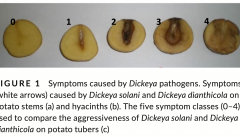
Teams
A new pathogen (and Winter) is coming ...
Paper title: Pattern and causes of the establishment of the invasive bacterial potato pathogen Dickeya solani and of the maintenance of the resident pathogen D. dianthicola. Molecular Ecology. 2020 Nov 23. doi: 10.1111/mec.15751.
A new pathogen is coming ... without chasing another one already present in the potato fields
Invasive pathogens can be a threat when they affect human health, food production or ecosystem services, by displacing resident species, and we need to understand the cause of their establishment. In this work, we studied the patterns and causes of the establishment of the bacterial pathogen Dickeya solani that recently invaded potato agrosystems in Europe.
We assessed (1) the invasion dynamics of D. solani in France using epidemiologic data collected from farmers’ fields, (2) its competitive ability against the closely-related resident Dickeya dianthicola species using experimental assays in greenhouse and (3) its natural genetic diversity using population genomics.
One decade of field survey showed that the D. solani invasion did not occur at the expense of D. dianthicola at the regional level (northern half of France). However, when we zoomed at the field level we observed that D. dianthicola and D. solani pathogens were not randomly distributed, suggesting competitive exclusion between the two pathogens. Plant infection assays showed that D. dianthicola exhibited a fitness advantage over D. solani in the wounded and unwounded potato plants, while D. solani exhibited a fitness advantage over D. dianthicola in potato tubers. In addition, D. solaniexhibited a fitness advantage over D. dianthicola in hyacinths, which constitute a reservoir or/and primary or intermediate host of D. solani. By comparing 67 D. solani genomes, only 45 non-synonym variations were identified. One of these variations resulted in the emergence of two different alleles of the vfmB gene involved in the poorly characterized quorum-sensing system in Dickeya pathogens. The isolates carrying one vfmB allele were more aggressive on tubers, while the isolates carrying the other vfmB allele were more competitive in potato plants. Such opposite gains across different plant organs could contribute to the maintenance of balanced frequencies of the two alleles in D. solani populations.
In conclusion, this study contributes to a better understanding of the pattern and causes of the D. solani invasion into potato production agrosystems, and explains why D. dianthicola nevertheless persisted. This study provides information to farmers for developing prophylactic strategies against these two pathogens.
This work was supported by the French National Research Agency (ANR) in the frame of the public-private collaborative project (PCRE) COMBICONTROL (ANR-15-CE21-0003) associating the public laboratories I2BC (Gif-sur-Yvette), MAP (Villeurbanne) and IEES (Paris) and the private partner FN3PT (Paris). This work also involved two public partners ESE (Orsay) and the University of Malaya (Malaysia).

